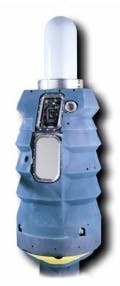Photonics mast systems for eight Block III Virginia-class attack submarines provided by Kollmorgen
WASHINGTON, 30 Dec. 2010.Military electro-optics engineers at Kollmorgen Electro-Optical in Northampton, Mass., will provide the U.S. Navy with eight AN/BVS-1 photonics mast systems for Virginia-class fast-attack submarines under terms of a $41.2 million contract announced Wednesday from Naval Sea Systems Command in Washington.
These eight photonics masts are for the Navy's Block III Virginia-class boats, which will feature a revised bow, including some technology from Ohio class guided-missile submarines. The AN/BVS-1 is a non-hull penetrating electronic imaging subsystem with visible light camera, infrared camera, and electronic support measures sensors, as well as stealth features that will provide new capabilities for attack submarines, Navy officials say.
A photonics mast is different from a traditional submarine optical periscope in that the photonics mast does not penetrate into the submarine's hull. Instead, it rises in a telescoping motion, similar to a car antenna. Sensors on the photonics mast interface to a remote-control console aboard the submarine.
Output from the photonics mast system can go to sophisticated computer workstations, and can be networked throughout the submarine. Each Virginia-class submarine will have two AN/BVS-1 photonics masts. Using a non-penetrating electro-optical system, rather than an optical periscope, gives submarine designers flexibility in locating the vessel's sail, as well as in the boat's interior layout.
Sensors mounted on the photonic mast include low-light television (LLTV), thermal imager, and laser rangefinder. The mast is the Universal Modular Mast developed by Kollmorgen and its Italian subsidiary, Calzoni. The submarine sensor suite performs surveillance, intelligence gathering, and electronic warfare, with a multispectral suite of a color and a monochrome high-definition TV cameras, a midwave infrared staring sensor, eye-safe laser rangefinder, as RF sensors.
The system brings infrared search and track (IRST) capabilities such as infrared and visual imaging, and digital image processing. A modified AN/BVS-1(V) is being developed for the Integrated Submarine Imaging System (ISIS) on guided-missile submarines as a replacement for the type 15L periscope.
This contract is for Virginia-class submarines hull numbers SSN-784 through SSN-791. The contract also includes spare parts and engineering services. Kollmorgen will do the work in Northampton, Mass.; Seattle; Westfield, Mass.; Amesbury, Mass.; Methuen, Mass.; Moonachie, N.J.; Joplin, Mo.; Southampton, Mass.; Orlando, Fla.; La Mirada, Calif.; Mason, Ohio; Westminster, Colo.; Radford, Va.; San Diego; Westfield, Mass.; Southwick, Mass.; and , Calif., and should be finished by March 2016.
For more information contact Kollmorgen Electro-Optical online at www.eo.kollmorgen.com, or Naval Sea Systems Command at www.navsea.navy.mil.

